Owning a cat is usually a rewarding relationship. Cats are wonderful company and provide endless amusement for their owners. However, sometimes cats exhibit undesirable behaviors that seem illogical.
Some cats show aggression toward owners or other animals. Scratching furniture and breaking household items is another common problem. Some cats eliminate outside their litter tray, while others act improperly around food. Excessive clinginess or verbalization and bringing prey corpses into the home are other common complaints.
There will be a reason for your cat behaving badly. Identifying this reason is the first step to rectifying bad behavior. Take the opportunity to retrain your cat and prevent this conduct from recurring in the future.
Why Is My Cat So Naughty?
Cats can be mischievous, and they like to test boundaries. Unfortunately, much like children, cats can sometimes go too far. A feline may inadvertently cross the line between playful and problematic.
However, many cats act out for a reason. What the human brain considers to be bad behavior is perfectly rational to a cat. This means that it is important to understand the thought process of your pet.
Let’s take a look at some common behavioral issues in cats and their meaning. If you understand why your cat acts this way, corrective training is likelier to be successful.
1/ Biting And Scratching
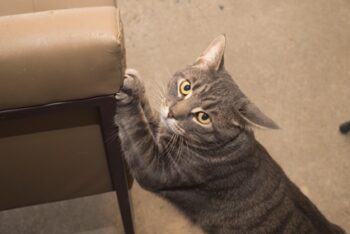
Of all the bad habits that cats exhibit, aggression toward owners is the least desirable. Sadly, The Journal of Veterinary Behavior describes aggression as the most common behavioral issue reported by cat owners.
Some cats are just belligerent by nature. This is rare, though. Cats usually attack when there is no other option. Cats will not willfully pick a fight with something that dwarfs them in size.
If your cat is behaving aggressively, especially if this is uncharacteristic, there will be a reason. Oftentimes, the cat is afraid or overstimulated.
Stress and Fear
If a cat is afraid, it will enter fight-or-flight mode. Most cats will take the latter option. A nervous, skittish cat will look for a hiding place until the apprehension passes.
This is not true of all cats, though. Some felines are bolder than others. In addition, a clear and obvious escape route may not present itself. In such a case, the cat will attack a source of fear head-on. The cat will feel that it needs to fight for its life.
It’s easier than you may realize to inflict stress upon a cat. Loud noises (including raised voices), sudden movements, and unwanted handling can provoke anxiety. The cat may also fear being picked up, especially if in pain.
If your cat displays the following body language and verbalizations, keep away. These suggest that the cat is planning an act of aggression.
- Back arched with tail up (aka the “Halloween Cat” pose)
- Staring without blinking
- Ears flat against the head
- Swiping with paws, claws unsheathed
- Hissing and growling
If your cat seems to be aggressive more often than not, seek advice. The cat may be in chronic pain. Some cats can also be traumatized by past events. Cats have long memories when it comes to mistreatment and distress.
Overstimulation
Overstimulation is a common complaint when petting a cat. There is a fine line between pleasure and pain. Touch a cat for too long and the skin becomes sore and tender. This will result in an act of aggression.
Your cat is not just being difficult. It will have provided you with a range of warnings that it was growing overstimulated. These include:
- Shifting and squirming
- Tail swishing wildly
- Watching your hands, akin to watching moving prey
- Growling
- Trying to escape
If you miss these signs, your cat will feel justified in clawing or biting. In your cat’s mind, it acted appropriately as it was being ignored. Always be mindful of a cat’s comfort while petting.
Cats can also grow overstimulated by visual stimulation. Take watching birds through a window as an example. Your cat will start to chirp, imitating the birds. What starts as fun can soon become aggravating. Your cat will grow frustrated at the inability to capture prey.
This energy needs to go somewhere. Usually, your cat will take out its frustrated hunting instincts on the next living thing it encounters. This could be you or another pet. Temper this urge with play.
2/ Bullying Other Pets
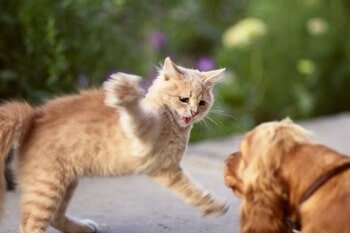
All feline families and colonies establish a pecking order among themselves. As explained by Animal Behavior, this is especially prevalent among males. Cats will fight among themselves for dominant status.
The dominant cat will usually eat first and have first refusal on human attention. Dominant cats will also claim more territory for themselves. As territory is so important to cats, alpha status is much sought-after.
In a multi-cat household, cats will arrange this hierarchy among themselves. There will be one dominant cat, with the others fulfilling a more submissive role. If all cats are happy with this, there is no problem.
Unfortunately, inter-cat dominance can cross the line into bullying. A dominant cat may prevent a submissive counterpart from eating, moving, sleeping, or playing with toys. This will cause no end of stress and anxiety for the submissive cat(s).
Spaying and/or neutering will help with dominant behavior. If the bullying continues, separate your cats and slowly re-introduce them. The cats must re-learn social boundaries and interaction. They may never be friends, but they can learn to co-exist peacefully.
3/ Scratching Furniture
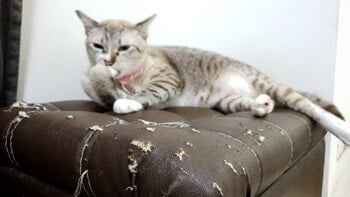
By scratching furniture, property, or carpets, a cat is sending a message to other felines. Scratch marks mean, “this area is claimed; go and find your own.” This also helps a cat feel calm and secure. It feels like it has claimed territory and thus will not be bothered.
In addition, a cat may simply be sharpening its claws. Cat claws grow constantly and can become overgrown. Scratching keeps them at an acceptable length. The cat will also feel its claws are sharp enough to defend itself if necessary.
This behavior can be managed with the introduction of a scratching post. This provides recreation and practical use for a cat. Your cat will soon lose interest in scratching other areas. Every usage releases scent, marking the scratching post as your cat’s property.
Never declaw a scratching cat. Declawing is the process of removing a cat’s claws. This is not as simple as cutting nails. Claws are an extension of a cat’s bones. Declawing is painful for a cat, will impact balance, and remove its ability to defend itself.
4/ House Soiling
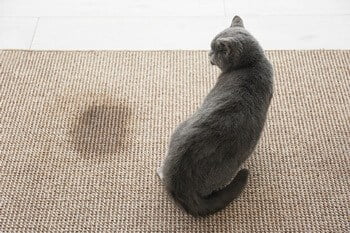
Eliminating outside the litter box can be a significant problem in cats. It is also often misunderstood. Contrary to opinion, inappropriate elimination is not a cat seeking revenge for a perceived slight.
Urinary house soiling is also known as periuria. As explained by Frontiers in Veterinary Science, this is divided into two sub-categories. Latrine behavior is the act of urinating outside the litter box. Marking, as it sounds, is a cat claiming territory through urine.
Marking is more common in multi-cat households. Cat pee smells strongly of ammonia to the human nose. For cats, it carries a multitude of messages. Cats typically mark in the home or on clothing to claim territory. Outdoor cats are likelier to mark at home than indoor cats.
Latrine behavior is more commonly linked to nerves. The Journal of the American Veterinary Medical Association links soiling a human bed to separation anxiety. The cat has an insecure bond with its owner. It worries that it has been abandoned.
It is also possible that you have forgotten to clean a cat’s litter box. Cats loathe eliminating in pre-soiled litter and grow distressed in unsanitary conditions. If your cat feels ignored, it may consider periuria a last resort to gain attention. Change litter regularly to prevent this.
5/ Food Aggression
Even a loving, docile feline can become aggressive and pushy around food. This is common in cats that previously lived in multi-pet homes. The cat may have struggled to access food. This makes it defensive about whatever nourishment it finds, perhaps eating its meal too quickly.
Food aggression must be managed. Feed your cat in a separate room, away from humans and other pets. Do not make any fuss or provide any attention. Leave the food and walk away. Let your cat eat and rejoin the family once it has calmed down.
Over time, your cat will regain confidence in eating. It will realize that nobody is interested in taking its food away. You’ll need to be patient with this, as it’s not an overnight process. Eventually, though, food aggression will fade.
6/ Stealing Human Food
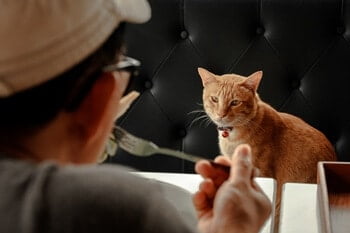
A cat that steals human food is not just annoying. It is also potentially hazardous. The cat may end up eating something toxic.
Cats steal human food as a matter of instinct. Cats are born hunters and predators and are typically food-focused. The chance to steal aromatic food is too tempting to pass up. The cat gets to simultaneously test its hunting mettle, gain a treat and satisfy instincts.
This behavior will become increasingly prominent in cats on a specialist diet. Older cats may be fed meals more tailored to heath than taste. This will make the temptation of a different meal increasingly prominent.
Consider your own role in this behavior. Do you feed your cat scraps while sitting at a table? If so, you cannot blame your cat for stealing food. You are sending a message that your food belongs to the cat. As far as your cat is concerned, it is just claiming its own property.
Your cat needs to learn the difference between cat food and human dinner. If possible, feed your cat in a different room at the same time as you eat. The use of a puzzle feeder will also appeal. This will slow down the cat’s eating and satisfy the instinct to ‘work’ for a meal.
7/ Refusing to Sleep at Night
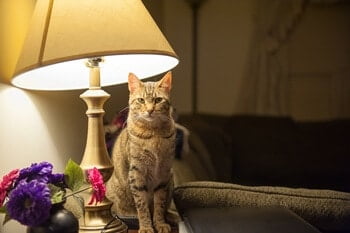
Typically, a cat that is active at night has excessive energy. Cats spend most of their day sleeping. Some felines spend up to sixteen hours dozing. When the cat is awake, it will be filled with energy.
This will lead to the cat running around the house, making a lot of noise. The cat may also vocalize and scratch you, demanding attention or food. This can become increasingly frustrating if you are trying to sleep.
Cats are not nocturnal by nature. They are crepuscular, meaning most active at dawn and dusk. This means that you can train your cat to follow your sleep pattern. It all comes down to finding an appropriate routine.
While cats nap throughout the day, they only have one main sleep. If your cat sleeps all day while you’re at work, it will be energetic overnight. Factor this into your cat’s schedule. Most cats sleep after eating. If you tire your cat out, it is even likelier to sleep when you do.
Play with your cat shortly before an evening meal. This will leave the cat sated and tired. Eating will further magnify this exhaustion. The cat will then groom itself and fall into a deep sleep. The later you do this, the likelier your cat is to sleep through the night.
Cognitive Decline
If routine changes do not work, consider your cat’s age. If your cat is 15 or older, it is considered geriatric. As explained by The Journal of Feline Medicine and Surgery, this means your cat may experience cognitive decline. This is essentially cat senility.
A reversed sleep-waking cycle is one of the key symptoms of feline cognitive dysfunction. This issue cannot be cured, but it can be slowed down. Keep your cat’s mind as sharp as possible and stick to a strict routine.
8/ Excessive Verbalization
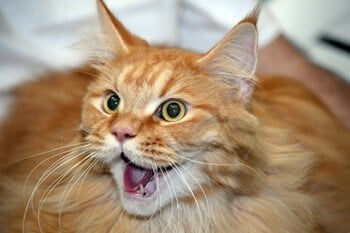
A cat that constantly meows and howls can be difficult to live with. Some cats are more vocal than others by nature. Others will verbalize more often when looking for attention or when in heat.
Attention
A cat that meows near-constantly, with the sound becoming increasingly urgent, is likely hungry. Ensure you have not missed a mealtime. Leave a supply of dry food for the cat to eat. Factor this into your cat’s food allowance so that it does not grow overweight.
If the cat is not hungry, it may want to show you something. Give the cat your attention. If it wanders off, follow the cat. It may show you a lost toy it cannot reach or a dirty litter box that needs attention.
The cat may also be frightened and seeking reassurance. If the cat follows up vocalization with rubbing, provide this attention. The cat will quickly feel calmer and leave you be. As long as the behavior is not constant, offer reassurance whenever needed.
Estrus
If your female cat has not been spayed, she will invariably enter estrus. A cat in heat will wail near constantly. She is trying to attract the attention of eligible tomcats in the area. This will not cease until the cat mates or her heat cycle concludes.
There is no resolution for this beyond spaying your cat. This is advisable if you do not plan to breed your cat. Spaying comes with health and psychological benefits. The cat will be calmer and less likely to develop UTIs or mammary cancer when older.
9/ Knocking Over Items

A common complaint is that cats knock items over, seemingly on purpose. While your cat may be willfully destructive, it may just be clumsy. Felines are graceful but far-sighted. Your cat may have accidentally bumped into something.
If you consider the act to be deliberate, there will be a reason. This varies depending on what the cat toppled. Your cat may have knocked a glass off a table. Alternatively, it may have knocked over its food or water bowl.
Glassware and Household Objects
Cats often knock items from shelves or tables. Glasses of water are a common example, but the cat may also knock over ornaments.
Sometimes, this behavior is simple curiosity. The cat is fascinated by watching items fall and the noise they make when they shatter. The only way around this is avoidance. Do not allow your cat close to any delicate items. Keeping your cat off countertops will also help.
Your cat may also be looking for attention. If your cat feels ignored, it will resort to behaviors that always garner a reaction. Vocalizations can be shrugged off. If you hear glass shatter, though, you’re likely to come running. Your cat knows this.
Do not react, no matter how angry you may be. If you tell your cat off, you are playing into its hands. The cat knows that this behavior will never fail to gain human attention. Instead, calmly clean up the mess.
Do not immediately give the cat attention for knocking something over. That is rewarding bad behavior and encouraging a repeat. Do make the effort to spend more time with your cat where possible, though. You must address your cat’s desire for stimulation.
Food Bowls
A cat that knocks a food bowl upside down is not protesting its meal. Usually, it will be a result of whisker fatigue.
A cat’s whiskers are sensitive and in use throughout the day. A cat’s whiskers provide balance, detect changes to air pressure, and judge space. If a cat’s whiskers fit into a space, the cat knows that it does too.
This means that a cat is constantly brushing its whiskers against items. Eventually, these whiskers grow tender. If they then rub against a food bowl while eating, the cat will be in pain.
It will topple the food onto the floor and eat from there. This way, the cat’s whiskers are not encountering resistance. Swopping a food bowl for a flat dish or saucer will resolve this problem.
Water Bowls
Toppling a water bowl is likelier to be an accident. Cats distrust still water. Your cat may have been nudging the water to make it ripple and move. If the cat pushes too hard, the bowl may topple over.
Cats are also fussy about the quantity of water in a bowl. Your cat may dip a paw in the bowl to test the water level. Unfortunately, after doing so, the cat considers the water contaminated. It will knock the bowl over for its own protection.
Both these problems can be eliminated by ceasing the use of water bowls. Instead, invest in a water fountain. Cats prefer to drink from a running water source. This way, your cat is likelier to remain hydrated and healthy.
10/ Presenting Dead Prey
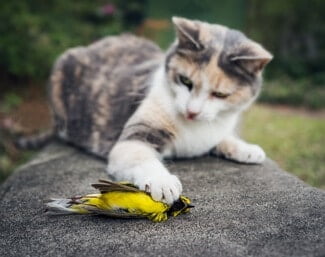
We have behavior that many cat owners loathe. Cats proudly display kills, leaving dead mice or birds on an owner’s pillow or kitchen floor. This can be upsetting for an owner who needs to dispose of the corpse.
It is important to note that your cat does not consider this bad behavior. Your cat is presenting you with a gift. This presentation could have several meanings:
- Pride – it wants to show what a skilled hunter it is
- Food – you feed your cat, and now it is returning the favor
- Affection – the cat is prepared to share the spoils of its hunt with its favorite human
Never scold a cat for presenting a corpse. Do not just throw it away in front of the cat, either. This will offend the cat. It won’t be your instinct, but praise and thank your cat. When the cat leaves, dispose of the corpse.
To prevent this behavior, play with your cat more frequently. All cats are driven to hunt by instinct to varying degrees. The more you play with toys, the more you can temper this desire.
In addition, you could fix your cat with a belled collar. This will announce the cat’s presence, giving prey the chance to escape. If you do this, additional play is essential. Your cat will grow frustrated by a lack of successful hunts. This energy must be redirected elsewhere.
Remember, every action that a cat undertakes has meaning. It could be borne of instinct, fear, frustration, or boredom. Whatever the explanation, bad behavior can be resolved with patience and training. This journey begins with understanding your cat and its bad habits.


We have female cat had kittens ln may this year.6 months old now. Her behaviour has become erratic Goes away for several days. We eventually comes back but is ggressive with her kittens and other 2 cats and humans.She is 1.5 years old mixed coloured cat.What does her behaviour mean and what can we do.